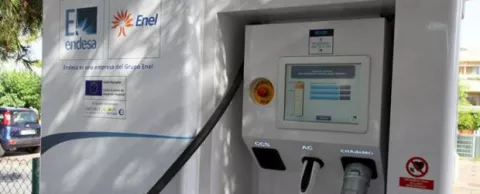
Endesa, a Spanish subsidiary of Council Lead Partner Enel and car maker Nissan, which manufactures the popular Leaf EV, are working together to bring vehicle-to-grid (V2G) to Europe in a big way. The two companies hope to be the first to introduce the energy storage technology throughout Europe.
While the Endesa-Nissan V2G partnership isn't the first attempt to transform EVs into rolling energy storage systems, the two companies already have conducted a number of successful demonstration projects, according to a Guardian article.
Why V2G?
"It's a technology that unlocks the potential of two-way charging and allows customers to reduce costs by selling power from electric vehicle batteries to the grid," explained Federico Caleno, end customer application and new technologies head for Enel. "EVs will become a critical part of the energy system, introducing new storage capacity at critical times and proving that energy stored in an EV can be used for applications other than just mobility."
The bi-directional capabilities of V2G technology offer what Endesa and Nissan see as several benefits for EV owners as well as governments and smart cities.
- V2G systems can behave as buffers for intermittent wind and solar power, storing power when there is plenty available and demand is low, and sending it back to the grid as needed
- EVs with V2G technology can be charged at off-peak times when electricity is less expensive, which cuts down on operating costs
- If needed, V2G can be used to provide power to homes for roughly two days – a capability likely to appeal to homeowners who have their own rooftop solar or wind power installations
- Large aggregations of EV fleet cars and other commercial vehicles, including buses (which have larger batteries), also can be used to contribute to the electric grid by augmenting capacity while they are plugged in for the night
There are some challenges
The last benefit mentioned also is one of the challenges to V2G technology. If it is to make meaningful contributions, such as peak shaving, a large volume of vehicles is required – and even better if they are in the same location.
Also, regulation and related legislation differ from country to country regarding who can provide electricity to the grid, which would prevent some EV owners from selling power.
Andy Cruden, professor of energy technology at the UK's University of Southampton, was quoted as saying, "Communications are also important, and grid operators will need to know how much potential storage from EV batteries is available at any one time, something that's made possible by the high level of telematics that many EVs already possess."
Another benefit, although in a different realm, is that V2G technology could help governments achieve CO2 reduction goals to meet climate change targets – and help cities reduce local pollution levels.
###
Doug Peeples is a Portland, Oregon-based writer specializing in technology and energy. Follow @smartccouncil on Twitter.
Related articles:
Electric cars in the real world: Daimler study reveals some surprises
Enel partners with Chinese telecom on renewables, smart grids, e-mobility



